Experimental and Numerical Investigation on Bearing Capacity of Circumferential Joint of New Spatial Steel Tubular Grid Arch in Mined Tunnel
Abstract
:1. Introduction
2. Engineering Background
3. Experimental Testing
3.1. Specimen Design and Test Condition
3.2. Test Equipments and Loading Scheme
3.3. Monitoring Scheme
4. Results and Discussion
4.1. Experiment Phenomenons
4.2. Deflection Displacement
- (1)
- When the bending moment is 0~180 kN·m, the curve increases linearly, and the maximum mid-span deflection is about 16.7 mm; the SSTG arches have no obvious deformation except for local small deformation.
- (2)
- When the bending moment is within the range of 180~300 kN·m, the curve shows approximately linear development, and the deflection growth rate gradually accelerates. At this time, mid-span deflection reaches 34.9 mm, and SSTG arches have a certain degree of bending deformation.
- (3)
- After the bending moment exceeds 300 kN·m, the deflection growth rate is further accelerated. When the bending moment reaches 340.5 kN·m, the deflection is 56.7 mm; reaching the ultimate bearing capacity, the SSTG arches fail to resist external load, and show a rapid growth of mid-span deflection.
4.3. Joint Opening
- (1)
- It can be seen from Figure 12 that at the initial stage of loading, the opening value of the joint increases slowly with the bending moment, and the maximum opening is about 3.0 mm.
- (2)
- When the load continues to be applied, the joint opening rate increases and the stiffness of the specimens decreases gradually, the maximum joint opening amount reaches 8.0 mm.
- (3)
- With the joint opening increasing rapidly, the vertical load improves further until the specimens reach the ultimate bearing capacity and lose the ability to resist deformation. When the ultimate bearing capacity is 340.5 kN·m, the joint opening deformation reaches 13.9 mm.
4.4. Steel Tube Strain
4.5. Flange Plate Strain
4.6. Rebar Strain
4.7. Bolt Axial Force
5. Finite Element Analysis
5.1. Numerical Modeling
5.2. Contact Setting and Bolt Load
5.3. Material Parameters
5.4. Results and Discussion
6. Conclusions
- (1)
- A new support technology of spatial steel tubular grid (SSTG) arch is proposed, in which high-strength seamless steel tube is used as the main load-bearing member, high-strength π-shaped rebar + U-shaped rebar are used as connecting rebar, and trapezoidal flange plate + high-strength bolts are used as the main connection of the joints. The SSTG arch has good mechanical performance with high strength and rigidity, which can bear the load of surrounding rock in real time, and ensure the safety of tunnel construction.
- (2)
- During the whole process of loading, the specimens experience elastic growth stage, plastic development stage, and final failure stage. The average ultimate bending moment of the three groups of specimens is about 340.5 kN·m, and the corresponding joint opening is about 13.9 mm.
- (3)
- The main limb steel tube is mainly subjected to bending deformation, and there is a certain degree of necking and sagging without obvious yield failure. The bolts on the tension side bear more tensile force, and the plastic zone is more widely distributed than the boils on the compression side. In addition, the bolts on the compression side are basically in the elastic deformation stage, and are still in good condition until the end of the loading. Furthermore, the π-shaped rebar shows obvious deformation and is broken locally during the loading process.
- (4)
- The failure of the specimen is mainly due to the plastic yield of the flange plates. The flange plates on the tension side have obvious opening deformation. In the yield stage, the opening deformation rate is significantly accelerated. Therefore, in engineering application, the thickness of flange plate could be appropriately increased to improve the anti-deformation ability of circumferential joint.
Author Contributions
Funding
Acknowledgments
Conflicts of Interest
References
- Wang, D.Y.; Liu, J.; Zhang, C.; Yuan, J.X.; Zhu, Y.Q.; Liu, H.; Cui, G.Y. Field tests on large deformation control method for surrounding rock of deep tunnel in fault zone with high geostress. Chin. J. Geotech. Eng. 2020, 45, 658–666. [Google Scholar]
- Fang, X.H.; Yang, Z.; Yang, J.S.; Peng, X.J.; Tang, Y.; Liu, W.L. Large Deformation Characteristics and Control Measures of Surrounding Rock in Altered Granite Stratum of High Ground Stress Tunnel. China Railw. Sci. 2020, 41, 92–101. [Google Scholar]
- Baumann, T.H.; Betzle, M. Investigation of the performance of lattice girders in tunnelling. Rock Mech. Rock Eng. 1984, 17, 67–81. [Google Scholar] [CrossRef]
- Nomikos, P.P.; Sofianos, A.I.; Sakkas, K.M.; Choumanidis, D.; Delendas, S. Nonlinear simulation of lattice girder segment tests. Tunn. Undergr. Space Technol. 2013, 38, 180–188. [Google Scholar] [CrossRef]
- Kim, H.J.; Song, K.I.; Jung, H.S.; Shin, Y.W.; Shin, J.H. Performance evaluation of lattice girder and significance of quality control. Tunn. Undergr. Space Technol. 2018, 82, 482–492. [Google Scholar] [CrossRef]
- Kim, S.; Han, T.H.; Baek, J.S.; Kang, Y.J. Evaluation of the structural performance of tetragonal lattice girders. Int. J. Steel Struct. 2013, 13, 31–47. [Google Scholar] [CrossRef]
- Qiu, W.G.; Lu, F.; Wang, G.; Huang, G.; Zhang, H.J.; Zhang, Z.Y.; Gong, C. Evaluation of mechanical performance and optimization design for lattice girders. Tunn. Undergr. Space Technol. 2019, 87, 100–111. [Google Scholar] [CrossRef]
- Zhang, D.L.; Chen, F.B.; Fang, Q. Study of mechanical characteristics and applicability of primary lining used in tunnel. Chin. Eng. Mech. 2014, 31, 78–84. [Google Scholar]
- Tan, Z.S. Application experimental study of high strength lattice girders with heat treatment in tunnel engineering. Hazard Control Tunn. Undergr. Eng. 2019, 1, 86–92. [Google Scholar]
- Yu, F.C.; Zhang, D.L.; Fang, Q.; Tai, Q.M.; Sun, Y. Experimental study of characteristics of composite support with high strength reinforcing lattice girders embedded in concrete. China Civ. Eng. J. 2015, 48, 104–111. [Google Scholar]
- Li, W.T.; Yang, N.; Yang, B.; Ma, H.Y.; Li, T.C.; Wang, Q.; Wang, G.; Du, Y.T.; Zhao, M.X. An improved numerical simulation approach for arch-bolt supported tunnels with large deformation. Tunn. Undergr. Space Technol. 2018, 77, 1–12. [Google Scholar] [CrossRef]
- Du, B.J.; Liu, C.Y.; Wu, F.F.; Yang, J.X. Deformation mechanism and control technology of roadway in deep mine with high stress and weak surrounding rock. J. Min. Saf. Eng. 2020, 37, 1123–1132. [Google Scholar]
- Jing, H.W.; Wu, J.Y.; Yin, Q.; Wang, K. Deformation and failure characteristics of anchorage structure of surrounding rock in deep roadway. Int. J. Min. Sci. Technol. 2020, 30, 593–604. [Google Scholar] [CrossRef]
- Yokota, Y.; Zhao, Z.Y.; Nie, W.; Date, K.; Iwano, K.; Koizumi, Y.; Okada, Y. Development of a new deformation-controlled rock bolt: Numerical modelling and laboratory verification. Tunn. Undergr. Space Technol. 2020, 98, 103305. [Google Scholar] [CrossRef]
- Xu, F.; Li, S.C.; Shi, S.S.; Li, L.P.; Wang, W.M.; Zhang, W.; Zhang, Q.Q.; He, P. Field test comparison of traditional and new type supporting structures in a phyllite tunnel. Chin. J. Rock Mech. Eng. 2017, 36, 609–621. [Google Scholar]
- Pang, J.Y.; Huang, J.K.; Liu, G.C.; Zhang, J.S. Experimental study on the structure of reinforced concrete reticulated shell support in soft rock roadway. J. Min. Saf. Eng. 2020, 37, 655–664. [Google Scholar]
- Li, X.B.; Yang, R.S.; Gao, Y.F.; Xue, H.J. Study on combined support technology of bolt-mesh-shotcrete and concrete filled steel tubular supports for soft rock roadway in Yangzhuang mine. J. Min. Saf. Eng. 2015, 32, 285–290. [Google Scholar]
- Liu, D.J.; Zuo, J.P.; Wang, J.; Zhang, T.L.; Liu, H.Y. Large deformation mechanism and concrete-filled steel tubular support control technology of soft rock roadway-A case study. Eng. Fail. Anal. 2020, 116, 104721. [Google Scholar] [CrossRef]
- Sun, H.B.; Li, S.C.; Wang, Q.; Zhou, L.S.; Jiang, B.; Zhang, X.; Xu, S.; Zhang, H.J. Research and application of fabricated confined concrete construction system for large cross section tunnel. China J. Highw. Transp. 2018, 31, 320–327. [Google Scholar]
- Wang, Q.; Xin, Z.X.; Jiang, B.; Sun, H.B.; Xiao, Y.C.; Bian, W.H.; Li, L.N. Comparative experimental study on mechanical mechanism of combined arches in large section tunnels. Tunn. Undergr. Space Technol. 2020, 99, 103386. [Google Scholar] [CrossRef]
- Li, S.C.; Lu, W.; Wang, Q.; Sun, H.B.; Jiang, B.; Qin, Q. Study on failure mechanism and mechanical properties of casing joints of square steel confined concrete arch. Eng. Fail. Anal. 2018, 92, 539–552. [Google Scholar] [CrossRef]
- Lu, W.; Sun, H.B. Study on support characteristic curve of concrete-filled steel tubular arch in underground support. Structures 2020, 27, 1809–1819. [Google Scholar] [CrossRef]
- Li, W.T.; Yang, N.; Mei, Y.C.; Zhang, Y.H.; Wang, L.; Ma, H.Y. Experimental investigation of the compression-bending property of the casing joints in a concrete filled steel tubular supporting arch for tunnel engineering. Tunn. Undergr. Space Technol. 2020, 96, 103184.1–103184.17. [Google Scholar] [CrossRef]
- Zhang, X.N.; Zhang, Y.; Shan, R.L.; Bai, Y.T.; Zhang, Z.H. Application on bending performance of annular concrete-filled steel tube stent. J. Constr. Steel Res. 2020, 168, 105984. [Google Scholar] [CrossRef]
- Wang, Q.; Xu, S.; Jiang, B.; Li, S.C.; Xiao, Y.C.; Xin, Z.X.; Liu, B.H. Research progress of confined concrete support theory and technology for underground engineering. J. China Coal Soc. 2020, 45, 2760–2776. [Google Scholar]
- China Machinery Industry. GB/T 1231-2006, Specifications of High Strength Bolts with Large Hexagon Head, Large Hexagon Nuts, Plain Washers for Steel Structures; Standards Press of China: Beijing, China, 2006. [Google Scholar]
- China Machinery Industry. GB 50017-2017, Standard for Design of Steel Structures; China Architecture & Building Press: Beijing, China, 2017. [Google Scholar]

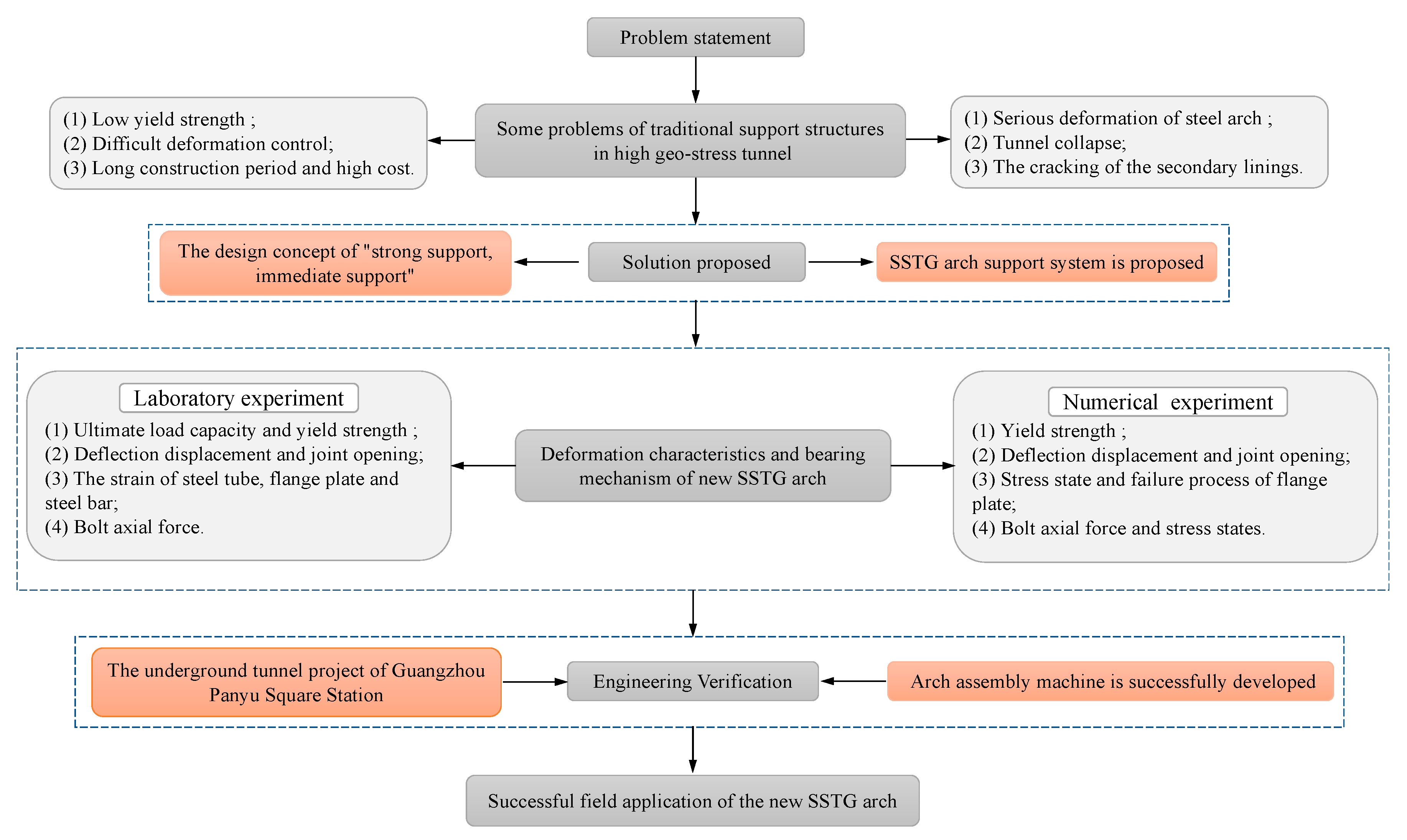
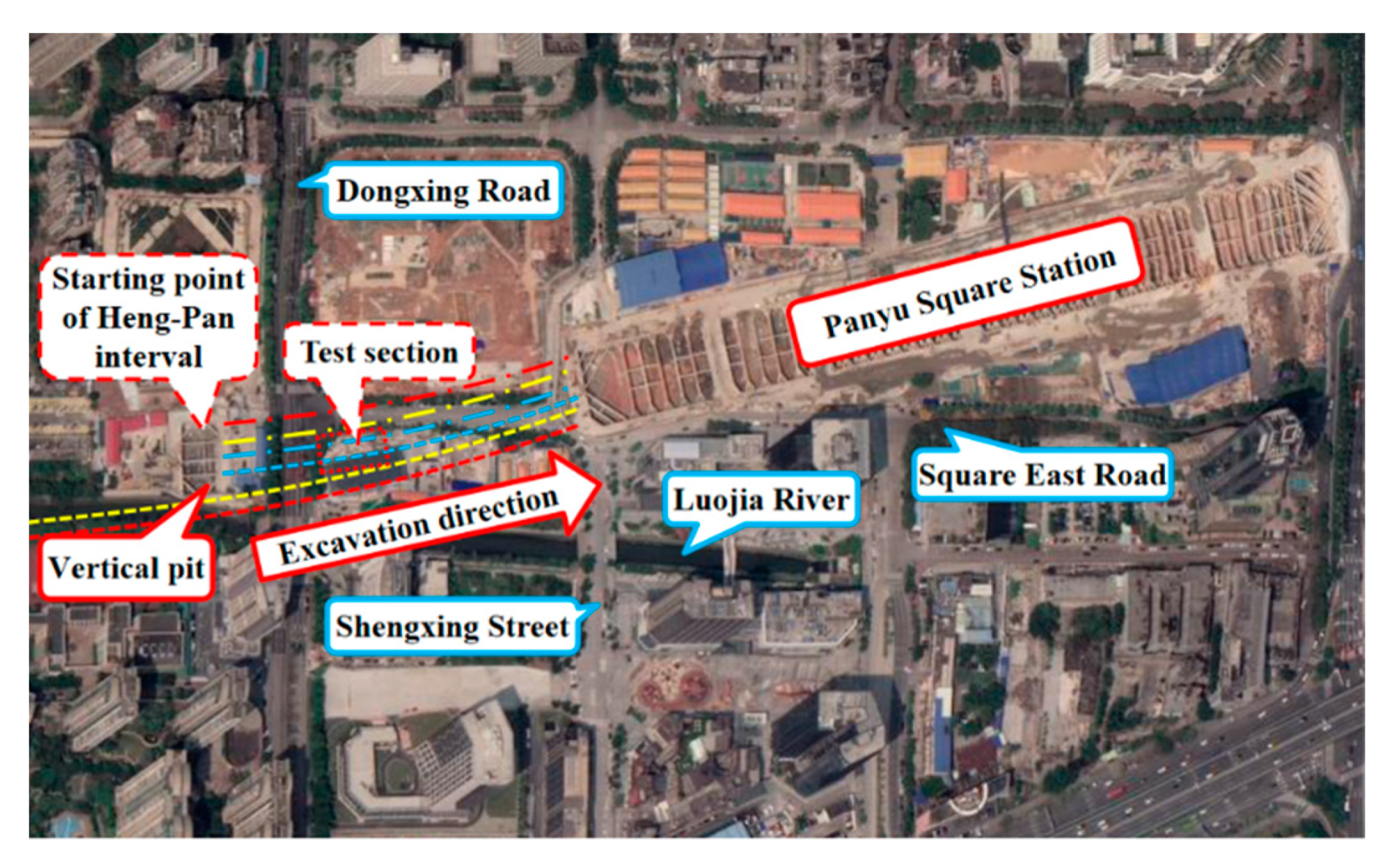
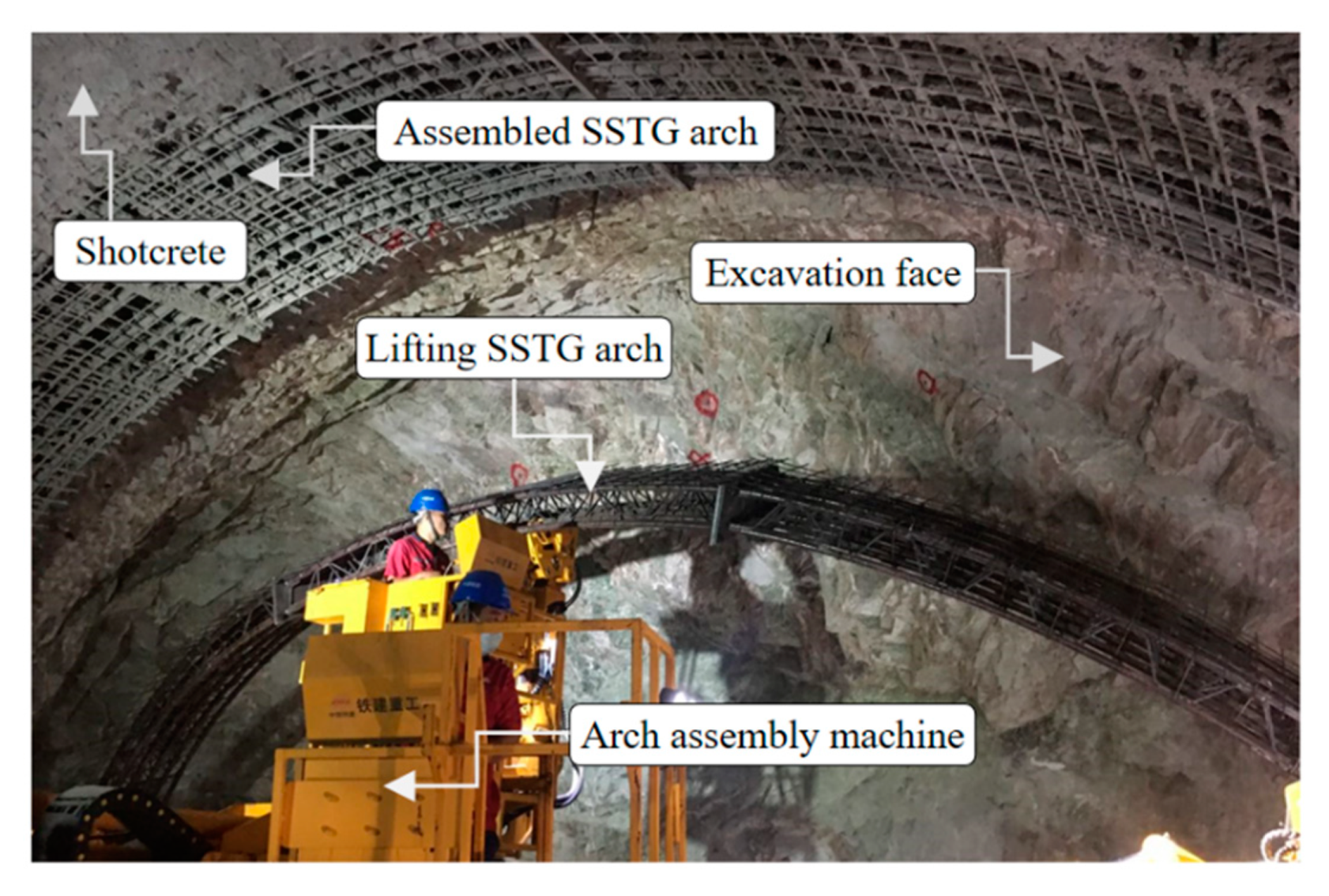
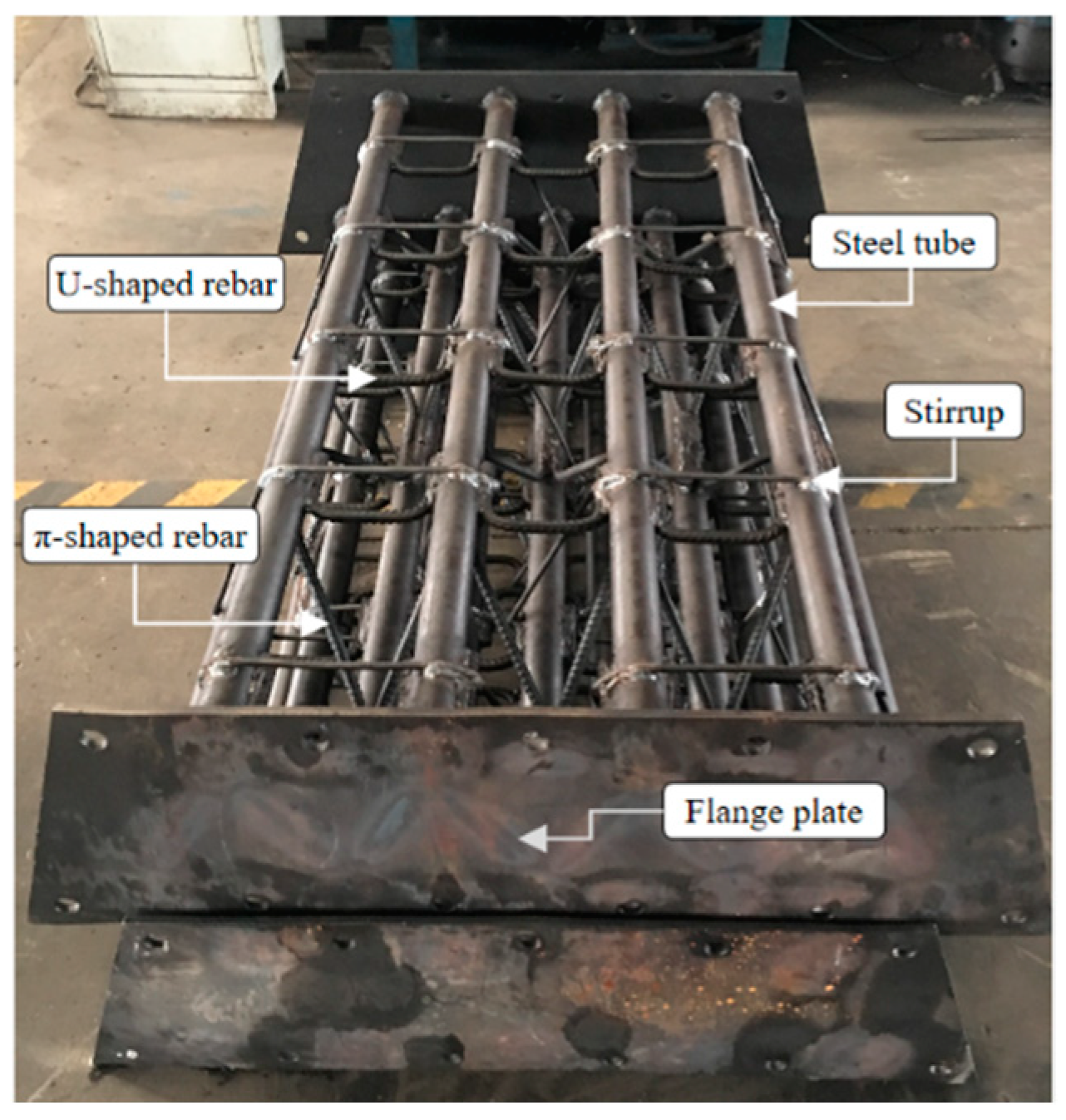


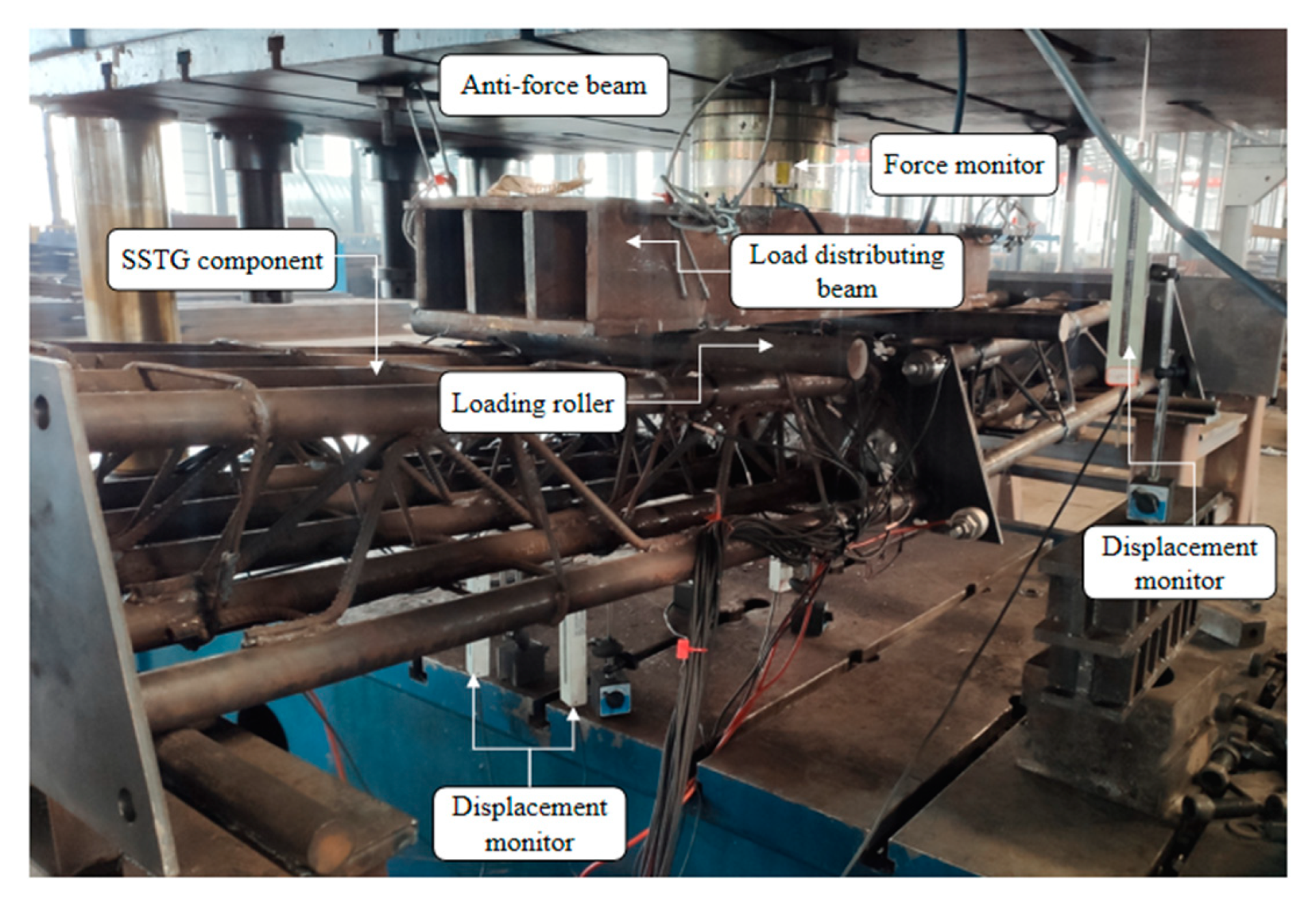
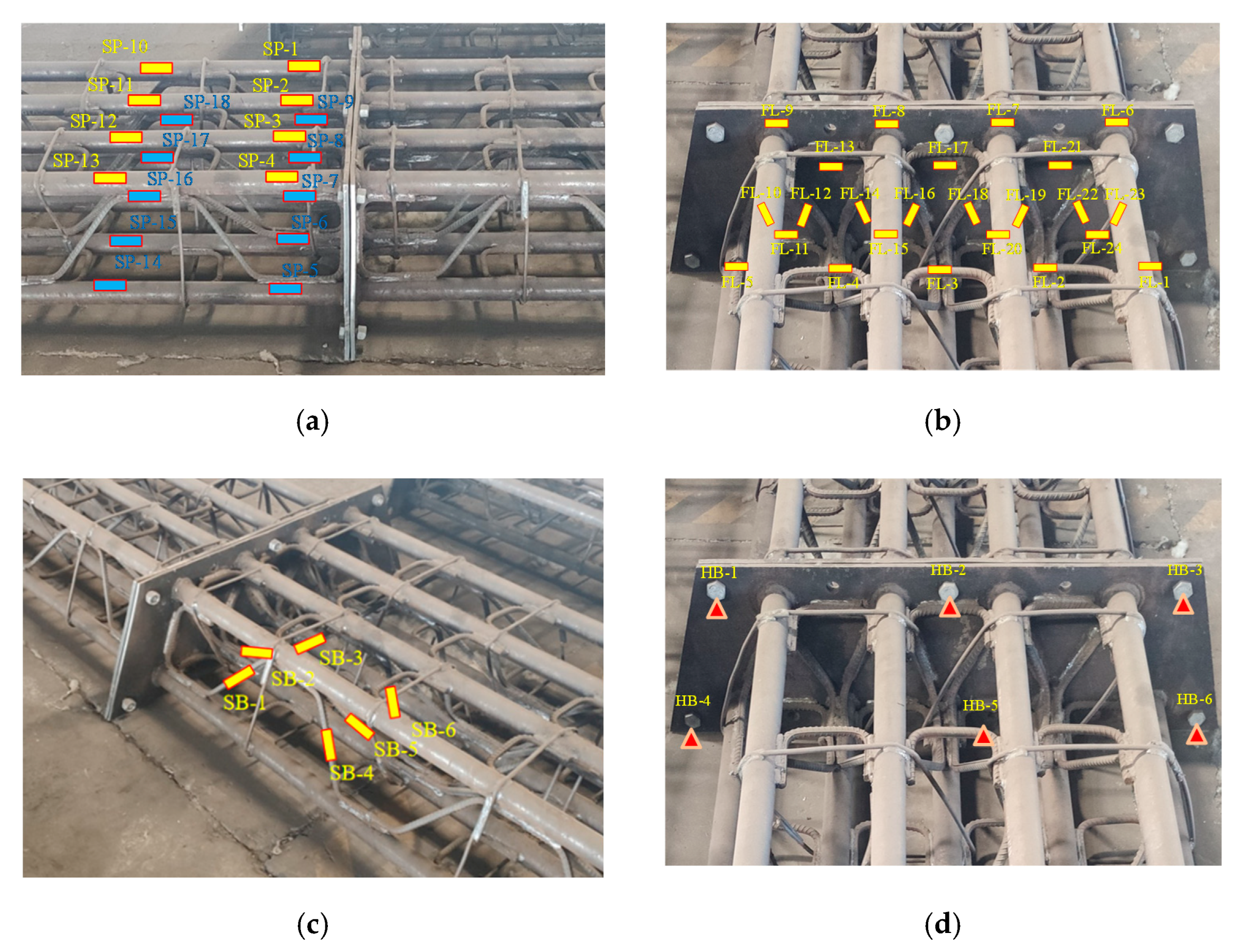



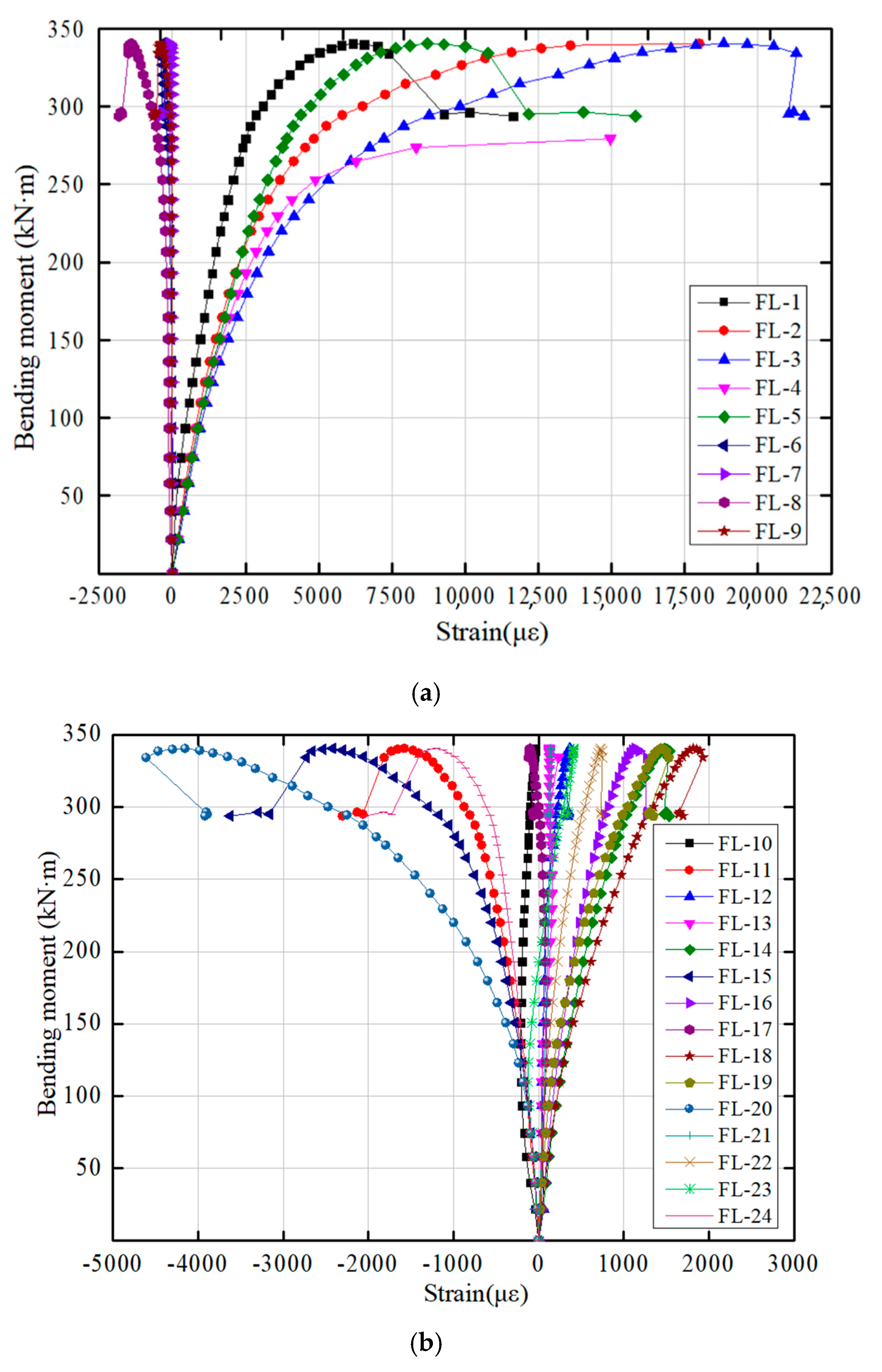

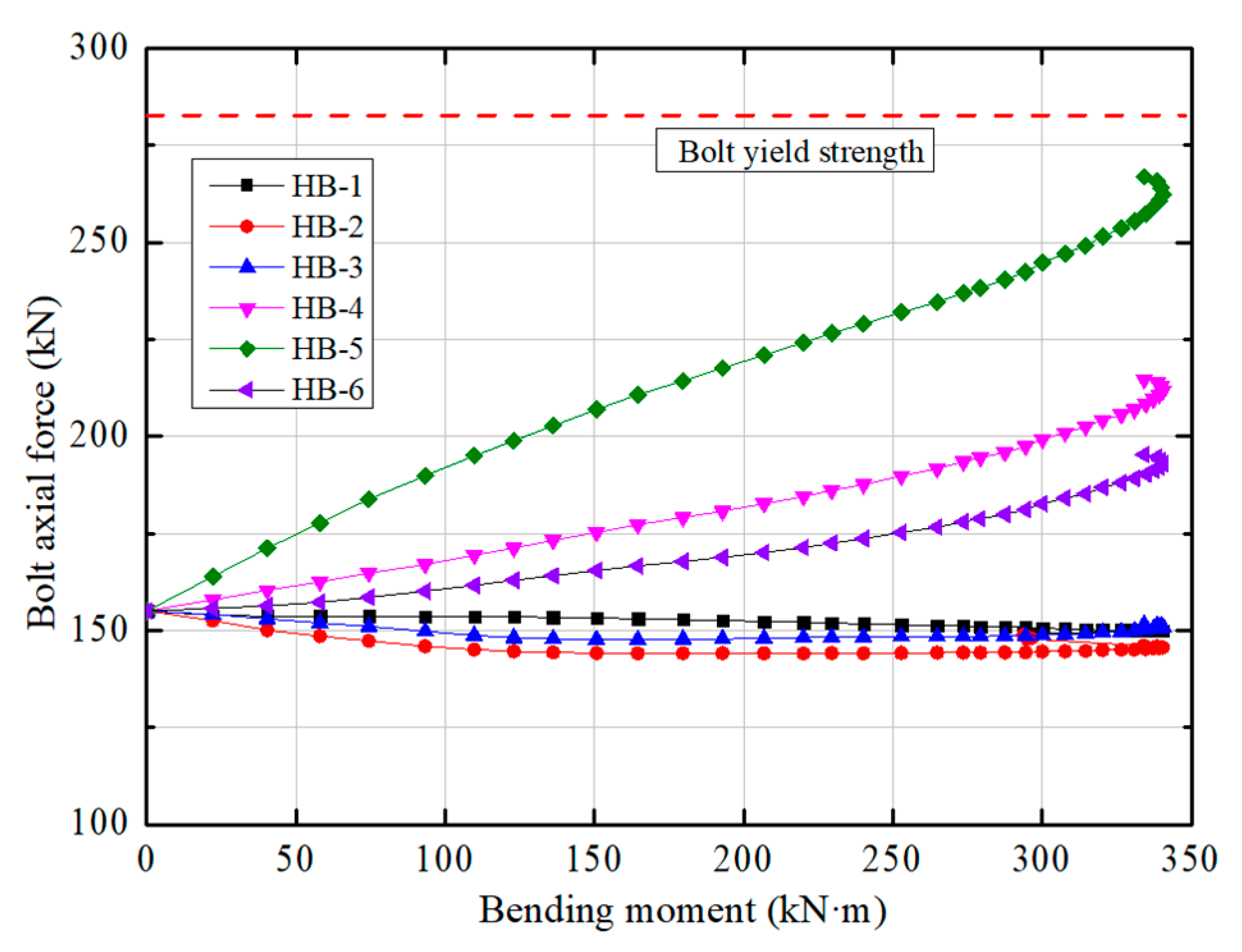

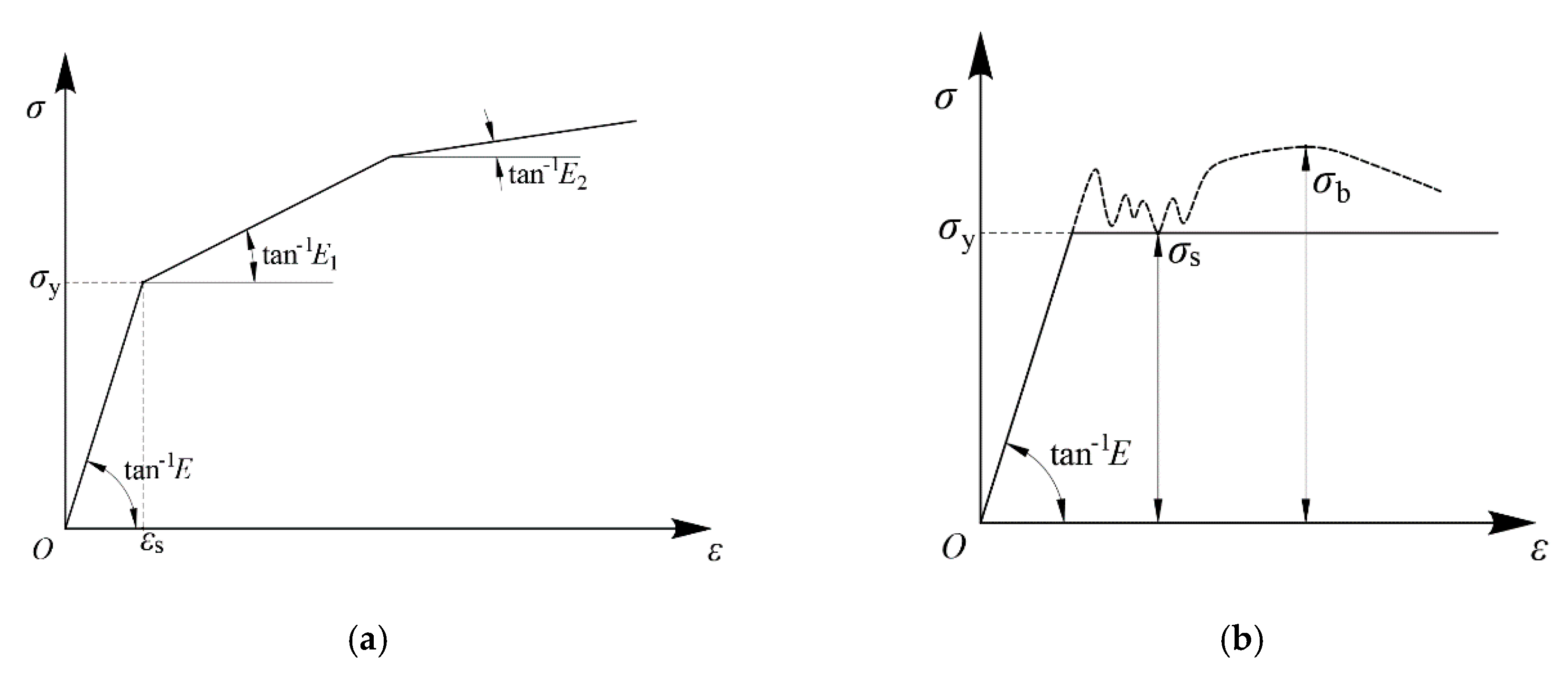

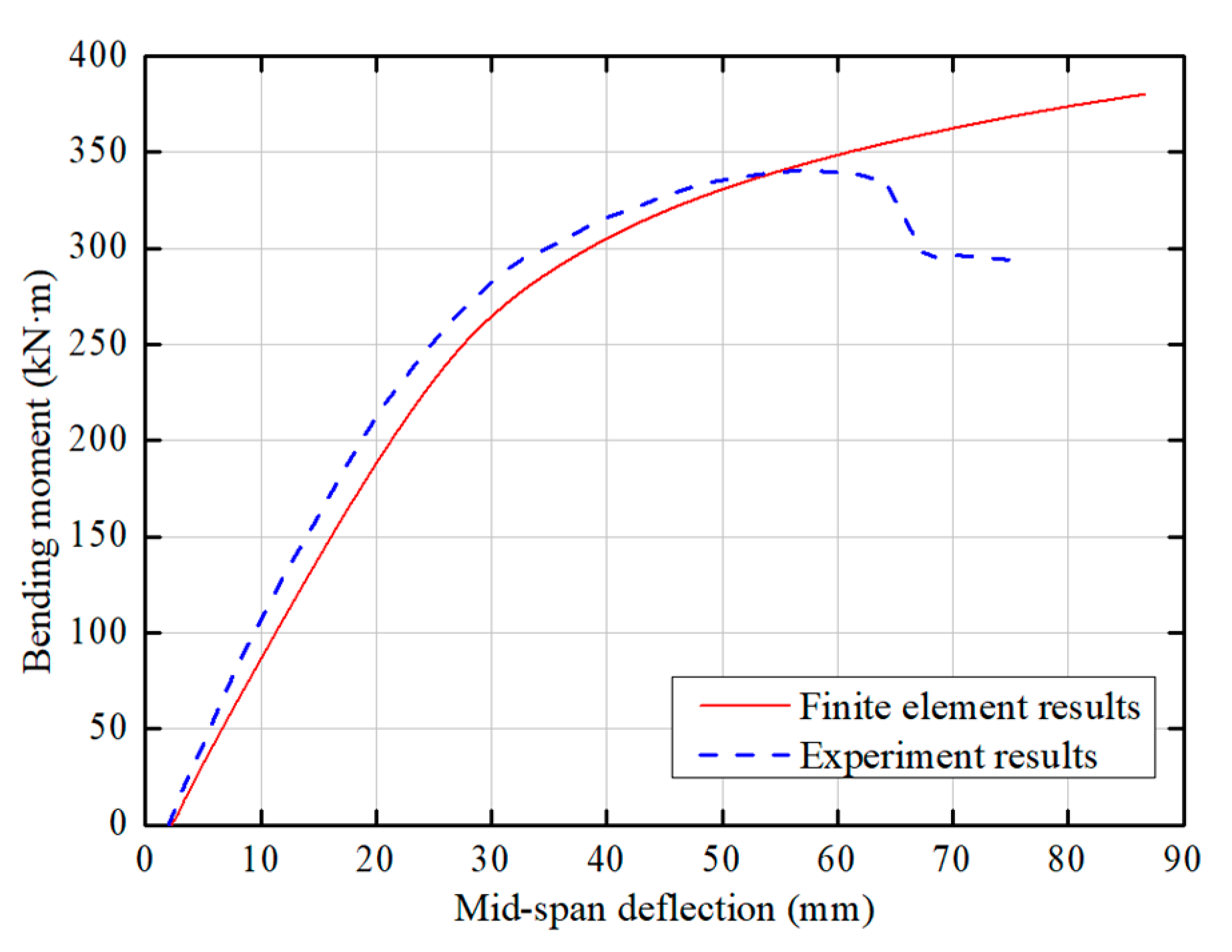
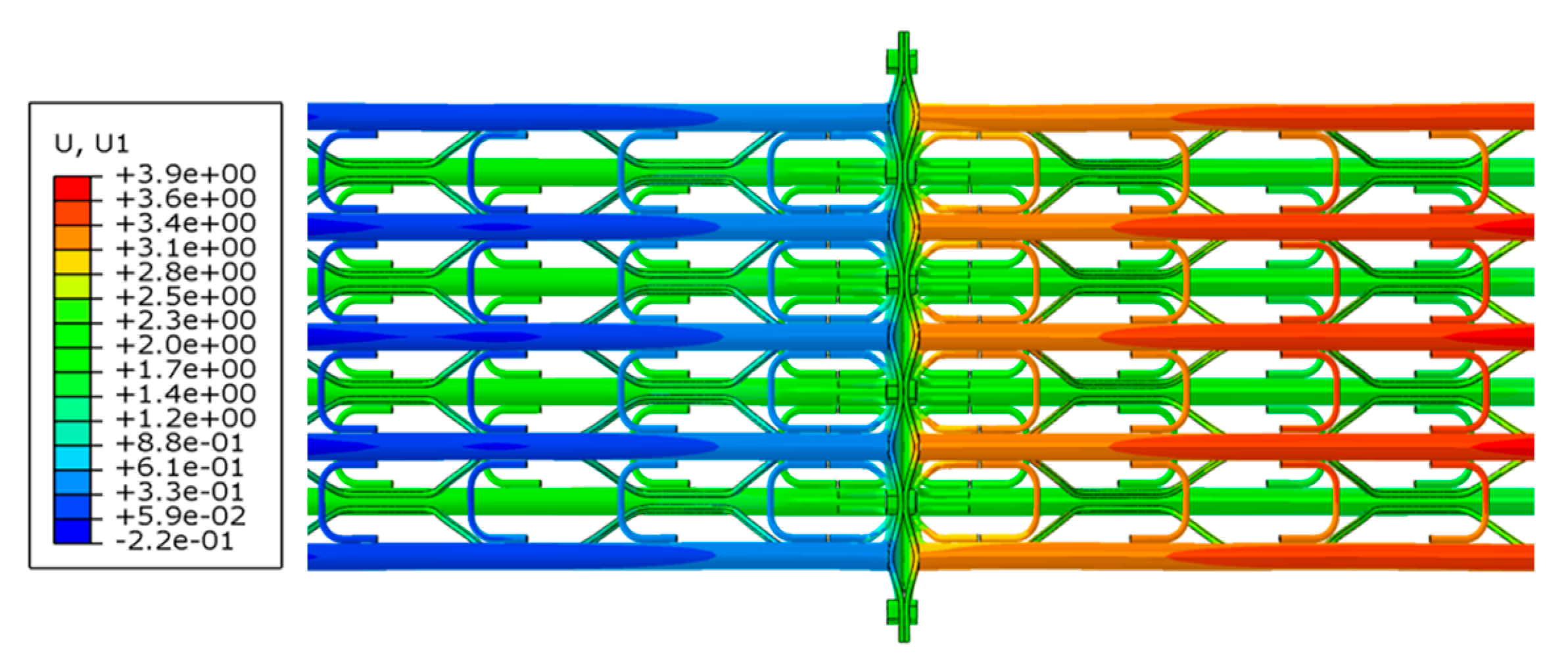
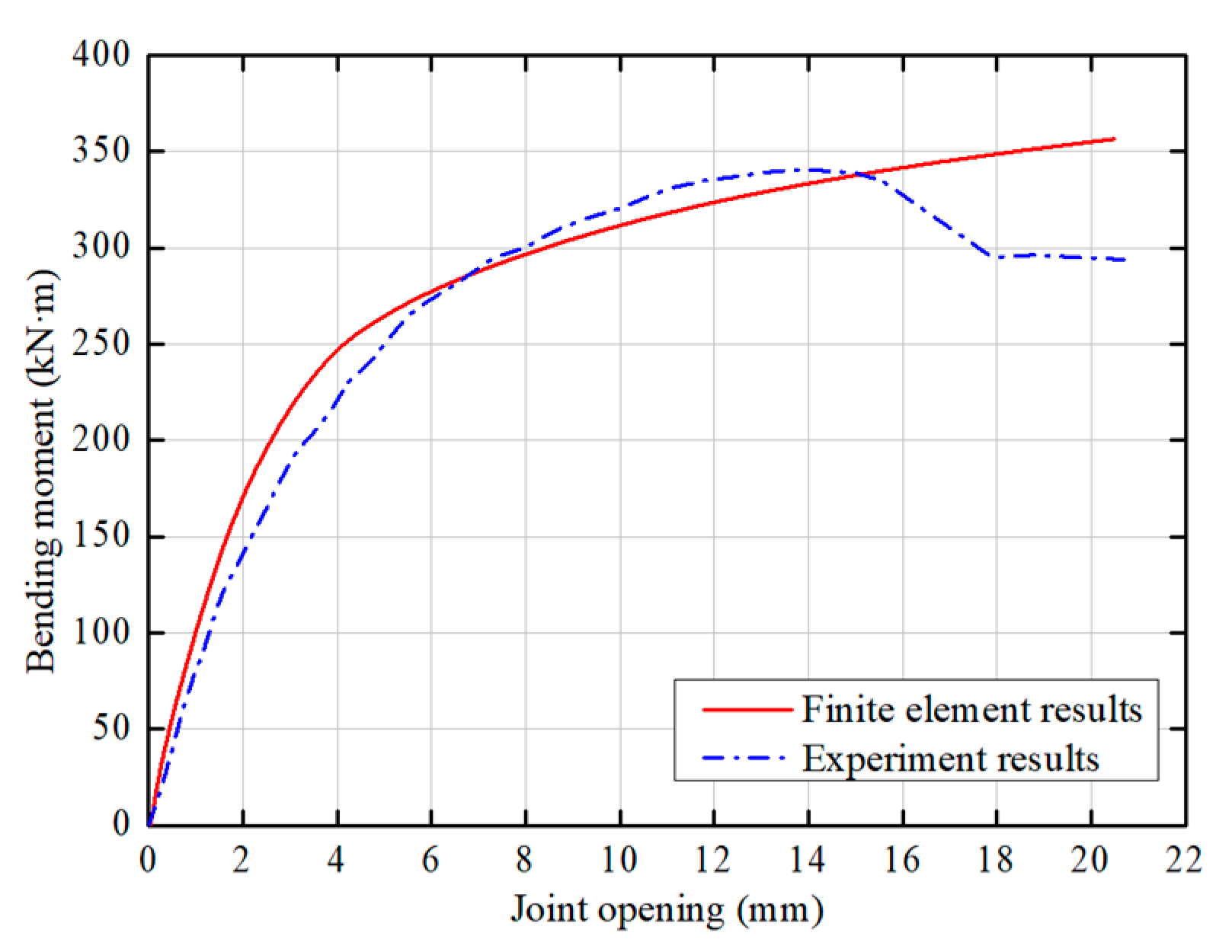
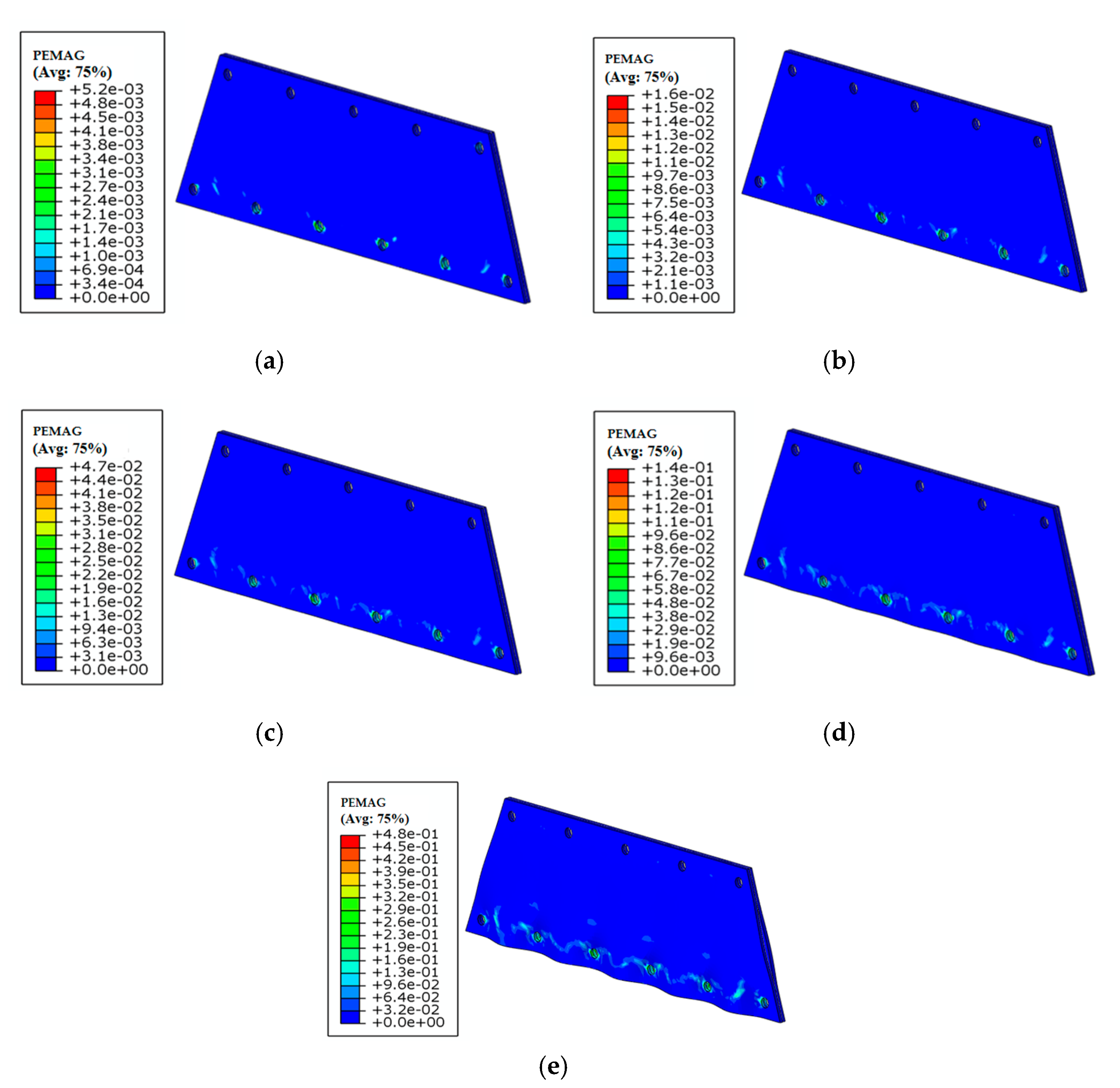

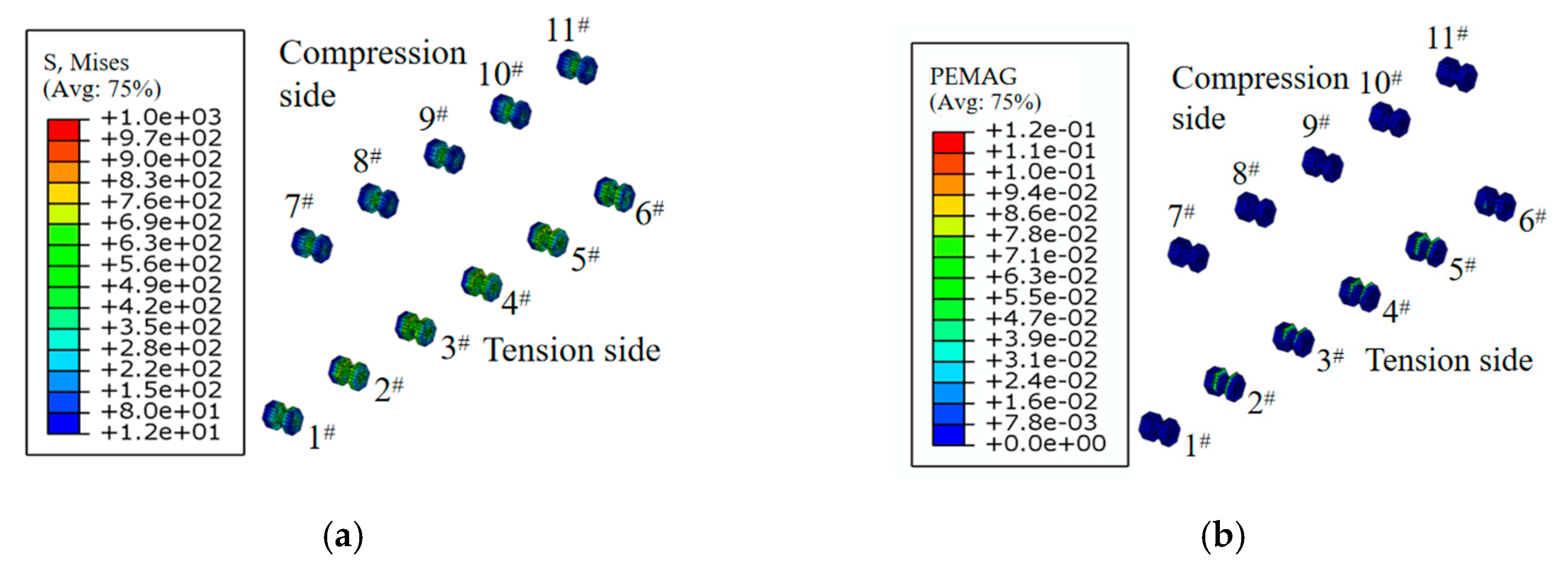
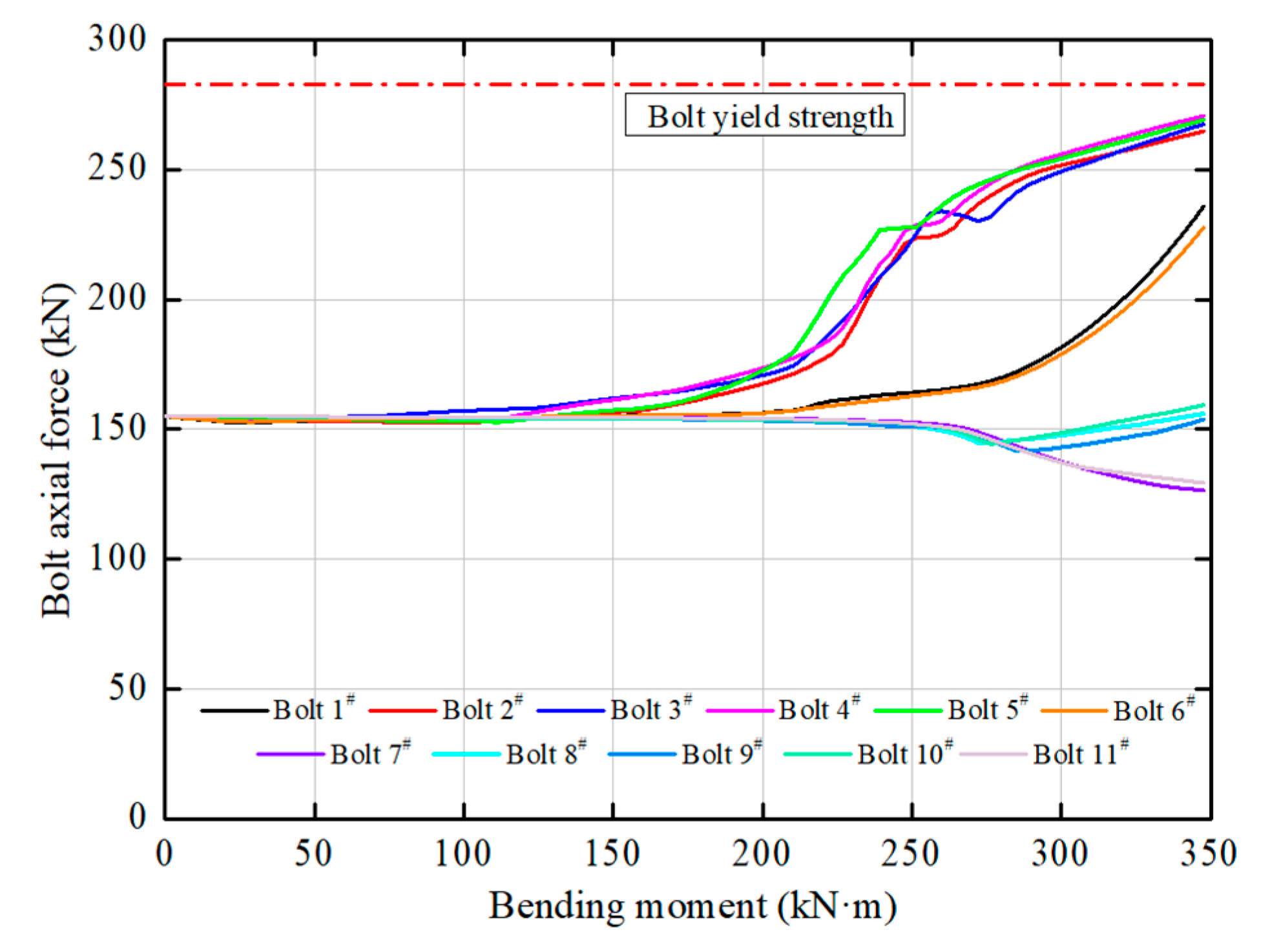
| Steel Tube | π-Shaped Rebar | U-Shaped Rebar | Flange Plate | Bolt | |||||
|---|---|---|---|---|---|---|---|---|---|
| Material | Size | Material | Diameter | Material | Diameter | Material | thickness | Grade | Size |
| Q420 | Φ50 × 8 | HRB400 | 14 | HRB400 | 14 | Q235B | 10 | 10.9 | M20 |
| Working Condition | Horizontal Load (kN) | Vertical Load (kN) | Bending Moment (kN·m) |
|---|---|---|---|
| Design condition | 640 | 412 | 200 |
| Failure condition | 640 | 614 | 298 |
| Test Item | Measuring Range | Accuracy | Quantity |
|---|---|---|---|
| The strain of steel tube | 0~0.02 | 1 × 10−6 | 18 |
| The strain of flange plate | 0~0.02 | 1 × 10−6 | 24 |
| The strain of π-shaped connecting rebar | 0~0.02 | 1 × 10−6 | 8 |
| Bolt axial force | 0~300 kN | 0.5 kN | 6 |
| Mid-span deflection | 0~100 mm | 0.1 mm | 2 |
| Joint opening | 0~50 mm | 0.1 mm | 2 |
Publisher’s Note: MDPI stays neutral with regard to jurisdictional claims in published maps and institutional affiliations. |
© 2020 by the authors. Licensee MDPI, Basel, Switzerland. This article is an open access article distributed under the terms and conditions of the Creative Commons Attribution (CC BY) license (http://creativecommons.org/licenses/by/4.0/).
Share and Cite
Song, Y.; Huang, M.; Zhang, X.; Li, Z.; Peng, X. Experimental and Numerical Investigation on Bearing Capacity of Circumferential Joint of New Spatial Steel Tubular Grid Arch in Mined Tunnel. Symmetry 2020, 12, 2065. https://doi.org/10.3390/sym12122065
Song Y, Huang M, Zhang X, Li Z, Peng X. Experimental and Numerical Investigation on Bearing Capacity of Circumferential Joint of New Spatial Steel Tubular Grid Arch in Mined Tunnel. Symmetry. 2020; 12(12):2065. https://doi.org/10.3390/sym12122065
Chicago/Turabian StyleSong, Yuan, Mingli Huang, Xudong Zhang, Zhaoping Li, and Xingxin Peng. 2020. "Experimental and Numerical Investigation on Bearing Capacity of Circumferential Joint of New Spatial Steel Tubular Grid Arch in Mined Tunnel" Symmetry 12, no. 12: 2065. https://doi.org/10.3390/sym12122065
APA StyleSong, Y., Huang, M., Zhang, X., Li, Z., & Peng, X. (2020). Experimental and Numerical Investigation on Bearing Capacity of Circumferential Joint of New Spatial Steel Tubular Grid Arch in Mined Tunnel. Symmetry, 12(12), 2065. https://doi.org/10.3390/sym12122065






